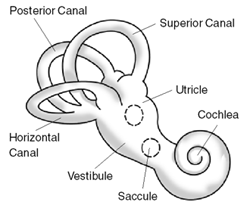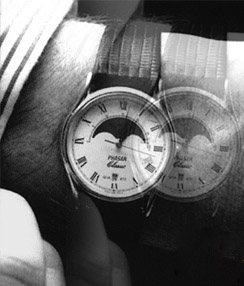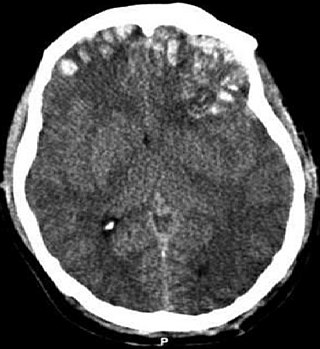Related Research Articles

Acute disseminated encephalomyelitis (ADEM), or acute demyelinating encephalomyelitis, is a rare autoimmune disease marked by a sudden, widespread attack of inflammation in the brain and spinal cord. As well as causing the brain and spinal cord to become inflamed, ADEM also attacks the nerves of the central nervous system and damages their myelin insulation, which, as a result, destroys the white matter. The cause is often a trigger such as from viral infection or vaccinations.
Ataxia is a neurological sign consisting of lack of voluntary coordination of muscle movements that can include gait abnormality, speech changes, and abnormalities in eye movements, that indicates dysfunction of parts of the nervous system that coordinate movement, such as the cerebellum.

Migraine is a genetically influenced complex neurological disorder characterized by episodes of moderate-to-severe headache, most often unilateral and generally associated with nausea and light and sound sensitivity. Other characterizing symptoms may include nausea, vomiting, cognitive dysfunction, allodynia, and dizziness. Exacerbation of headache symptoms during physical activity is another distinguishing feature. Up to one-third of migraine sufferers experience aura: a premonitory period of sensory disturbance widely accepted to be caused by cortical spreading depression at the onset of a migraine attack. Although primarily considered to be a headache disorder, migraine is highly heterogenous in its clinical presentation and is better thought of as a spectrum disease rather than a distinct clinical entity. Disease burden can range from episodic discrete attacks, consisting of as little as several lifetime attacks, to chronic disease.

Ménière's disease (MD) is a disease of the inner ear that is characterized by potentially severe and incapacitating episodes of vertigo, tinnitus, hearing loss, and a feeling of fullness in the ear. Typically, only one ear is affected initially, but over time, both ears may become involved. Episodes generally last from 20 minutes to a few hours. The time between episodes varies. The hearing loss and ringing in the ears can become constant over time.
A balance disorder is a disturbance that causes an individual to feel unsteady, for example when standing or walking. It may be accompanied by feelings of giddiness, or wooziness, or having a sensation of movement, spinning, or floating. Balance is the result of several body systems working together: the visual system (eyes), vestibular system (ears) and proprioception. Degeneration or loss of function in any of these systems can lead to balance deficits.
Neuropsychiatric quinism is a chronic encephalopathy due to intoxication by mefloquine, quinacrine, chloroquine. It is associated with brain dysfunction and brainstem dysfunction. It may be confused as posttraumatic stress disorder (PTSD) and traumatic brain injury (TBI). In the opinion of one medical author it "may have been widely unrecognized in veteran populations, and its symptoms misattributed to other causes." Symptoms include, but are not limited to, limbic encephalopathy and neurotoxic vestibulopathy.

Dizziness is an imprecise term that can refer to a sense of disorientation in space, vertigo, or lightheadedness. It can also refer to disequilibrium or a non-specific feeling, such as giddiness or foolishness.

Labyrinthitis is inflammation of the labyrinth, a maze of fluid-filled channels in the inner ear. Vestibular neuritis is inflammation of the vestibular nerve. Both conditions involve inflammation of the inner ear. Labyrinths that house the vestibular system sense changes in the head's position or the head's motion. Inflammation of these inner ear parts results in a sensation of the world spinning and also possible hearing loss or ringing in the ears. It can occur as a single attack, a series of attacks, or a persistent condition that diminishes over three to six weeks. It may be associated with nausea, vomiting, and eye nystagmus.

Diplopia is the simultaneous perception of two images of a single object that may be displaced horizontally or vertically in relation to each other. Also called double vision, it is a loss of visual focus under regular conditions, and is often voluntary. However, when occurring involuntarily, it results in impaired function of the extraocular muscles, where both eyes are still functional, but they cannot turn to target the desired object. Problems with these muscles may be due to mechanical problems, disorders of the neuromuscular junction, disorders of the cranial nerves that innervate the muscles, and occasionally disorders involving the supranuclear oculomotor pathways or ingestion of toxins.

Benign paroxysmal positional vertigo (BPPV) is a disorder arising from a problem in the inner ear. Symptoms are repeated, brief periods of vertigo with movement, characterized by a spinning sensation upon changes in the position of the head. This can occur with turning in bed or changing position. Each episode of vertigo typically lasts less than one minute. Nausea is commonly associated. BPPV is one of the most common causes of vertigo.

A traumatic brain injury (TBI), also known as an intracranial injury, is an injury to the brain caused by an external force. TBI can be classified based on severity ranging from mild traumatic brain injury (mTBI/concussion) to severe traumatic brain injury. TBI can also be characterized based on mechanism or other features. Head injury is a broader category that may involve damage to other structures such as the scalp and skull. TBI can result in physical, cognitive, social, emotional and behavioral symptoms, and outcomes can range from complete recovery to permanent disability or death.

Hallucinogen persisting perception disorder (HPPD) is a non-psychotic disorder in which a person experiences apparent lasting or persistent visual hallucinations or perceptual distortions after a previous use of drugs, including but not limited to psychedelics, dissociatives, entactogens, tetrahydrocannabinol (THC), and SSRIs. Despite being designated as a hallucinogen-specific disorder, the specific contributory role of psychedelic drugs is unknown.

Betahistine, sold under the brand name Serc among others, is an anti-vertigo medication. It is commonly prescribed for balance disorders or to alleviate vertigo symptoms. It was first registered in Europe in 1970 for the treatment of Ménière's disease but current evidence does not support its efficacy in treating it.

Vertigo is a condition in which a person has the sensation of movement or of surrounding objects moving when they are not. Often it feels like a spinning or swaying movement. This may be associated with nausea, vomiting, sweating, or difficulties walking. It is typically worse when the head is moved. Vertigo is the most common type of dizziness.

The vestibular nerve is one of the two branches of the vestibulocochlear nerve. In humans the vestibular nerve transmits sensory information transmitted by vestibular hair cells located in the two otolith organs and the three semicircular canals via the vestibular ganglion of Scarpa. Information from the otolith organs reflects gravity and linear accelerations of the head. Information from the semicircular canals reflects rotational movement of the head. Both are necessary for the sensation of body position and gaze stability in relation to a moving environment.

Cinnarizine is an antihistamine and calcium channel blocker of the diphenylmethylpiperazine group. It is prescribed for nausea and vomiting due to motion sickness or other sources such as chemotherapy, vertigo, or Ménière's disease.
The semicircular canal dehiscence (SCD) is a category of rare neurotological diseases/disorders affecting the inner ears, which gathers the superior SCD, lateral SCD and posterior SCD. These SCDs induce SCD syndromes (SCDSs), which define specific sets of hearing and balance symptoms. This entry mainly deals with the superior SCDS.

Central nervous system diseases or central nervous system disorders are a group of neurological disorders that affect the structure or function of the brain or spinal cord, which collectively form the central nervous system (CNS). These disorders may be caused by such things as infection, injury, blood clots, age related degeneration, cancer, autoimmune disfunction, and birth defects. The symptoms vary widely, as do the treatments.
Vestibular migraine (VM) is vertigo with migraine, either as a symptom of migraine or as a related neurological disorder.
Cramp fasciculation syndrome (CFS) is a rare peripheral nerve hyperexcitability disorder. It is more severe than the related disorder known as benign fasciculation syndrome; it causes fasciculations, cramps, pain, fatigue, and muscle stiffness similar to those seen in neuromyotonia. Patients with CFS, like those with neuromyotonia, may also experience paresthesias. Most cases of cramp fasciculation syndrome are idiopathic.
References
- ↑ Strupp, M.; Feil, K.; Dieterich, M.; Brandt, T. (2016). "Bilateral vestibulopathy". Handbook of Clinical Neurology. 137: 235–40. doi:10.1016/B978-0-444-63437-5.00017-0. ISBN 9780444634375. PMID 27638075. S2CID 26039856.
- ↑ Choi, J. Y.; Lee, S. H.; Kim, J. S. (2018). "Central vertigo". Current Opinion in Neurology. 31 (1): 81–89. doi:10.1097/WCO.0000000000000511. PMID 29084063. S2CID 13348432.
- ↑ Fife, T. D.; Kalra, D. (2015). "Persistent vertigo and dizziness after mild traumatic brain injury". Annals of the New York Academy of Sciences. 1343 (1): 97–105. Bibcode:2015NYASA1343...97F. doi:10.1111/nyas.12678. PMID 25728715. S2CID 40780173.
- ↑ Strupp, M.; Mandalà, M.; López-Escámez, J. A. (2019). "Peripheral vestibular disorders: An update". Current Opinion in Neurology. 32 (1): 165–173. doi:10.1097/WCO.0000000000000649. PMID 30562267. S2CID 56476616.
- ↑ Rutka, J. A.; Barber, H. O. (1986). "Recurrent vestibulopathy: Third review". The Journal of Otolaryngology. 15 (2): 105–7. PMID 3712538.
- ↑ Guerraz, M.; Yardley, L.; Bertholon, P.; Pollak, L.; Rudge, P.; Gresty, M. A.; Bronstein, A. M. (2001). "Visual vertigo: Symptom assessment, spatial orientation and postural control". Brain. 124 (8): 1646–1656. doi: 10.1093/brain/124.8.1646 . PMID 11459755.
- ↑ Nevin, Remington L.; Leoutsakos, Jeannie-Marie (2017). "Identification of a Syndrome Class of Neuropsychiatric Adverse Reactions to Mefloquine from Latent Class Modeling of FDA Adverse Event Reporting System Data". Drugs in R&D. 17 (1): 199–210. doi:10.1007/s40268-016-0167-3. PMC 5318335 . PMID 28063022.
- ↑ Semaan, M. T.; Megerian, C. A. (2011). "Ménière's disease: A challenging and relentless disorder". Otolaryngologic Clinics of North America. 44 (2): 383–403, ix. doi:10.1016/j.otc.2011.01.010. PMID 21474013.